We can't all get down to Cape Canaveral, so we've rounded up the best model rockets on the market, suitable for all ages and budgets.
The best model rockets are small-scale models that you can launch with varying degrees of thrust. You'll need more than just the rocket itself, usually a launch pad, an engine and a landing system too. It's also important to have open space when launching, for safety reasons and for a safer landing. Below, you'll find the best models, replicas and STEM sets on the market today.
You'll find model rockets suitable for different experience levels, ranging from beginner to master. However, if you're curious about space but model rockets aren't your thing, you can always check out the best Lego space sets, which include the epic Lego NASA Artemis SLS or our best telescopes guide. But, for the best model rockets, scroll down below.
The Quick List
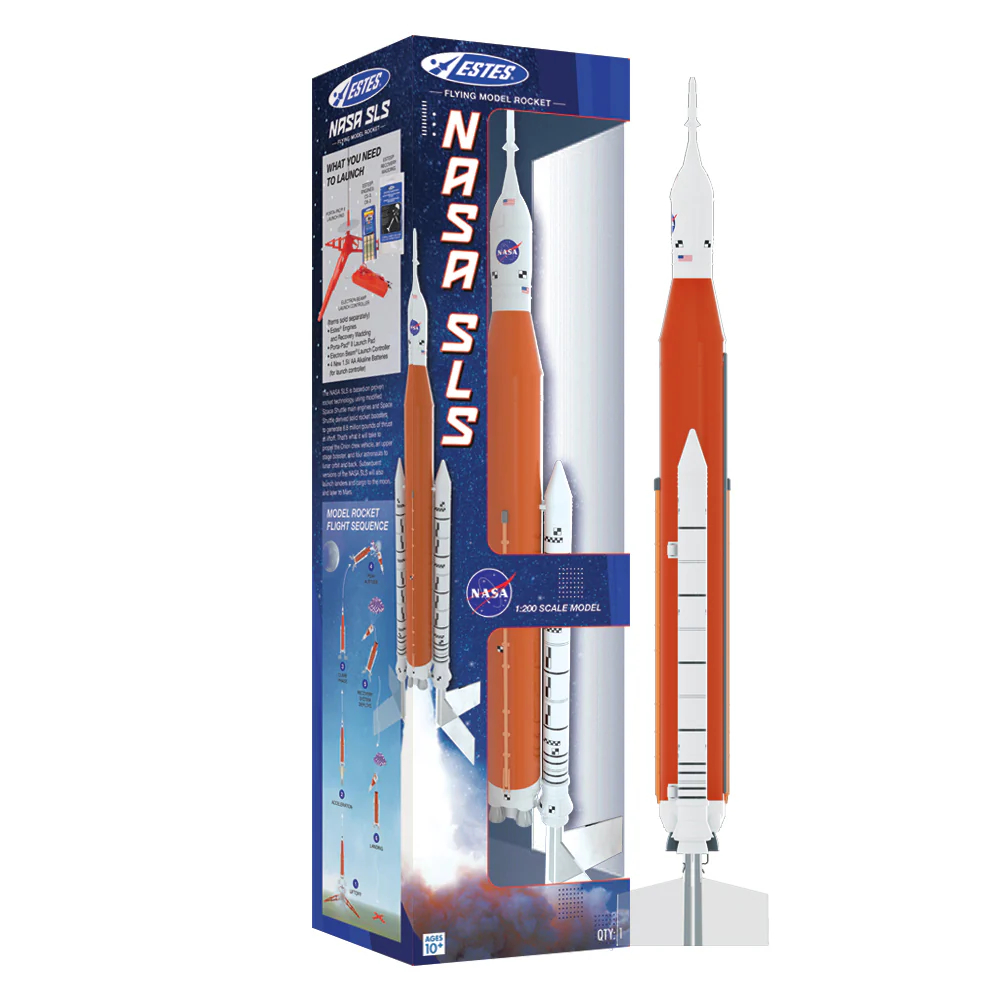 Best SLS model rocket
Best SLS model rocket
The Estes SLS is the perfect introduction to model rockets and a fantastic homage to NASA's new spacecraft. It's affordable, easy to build and fly, and looks awesome — what more could you want?
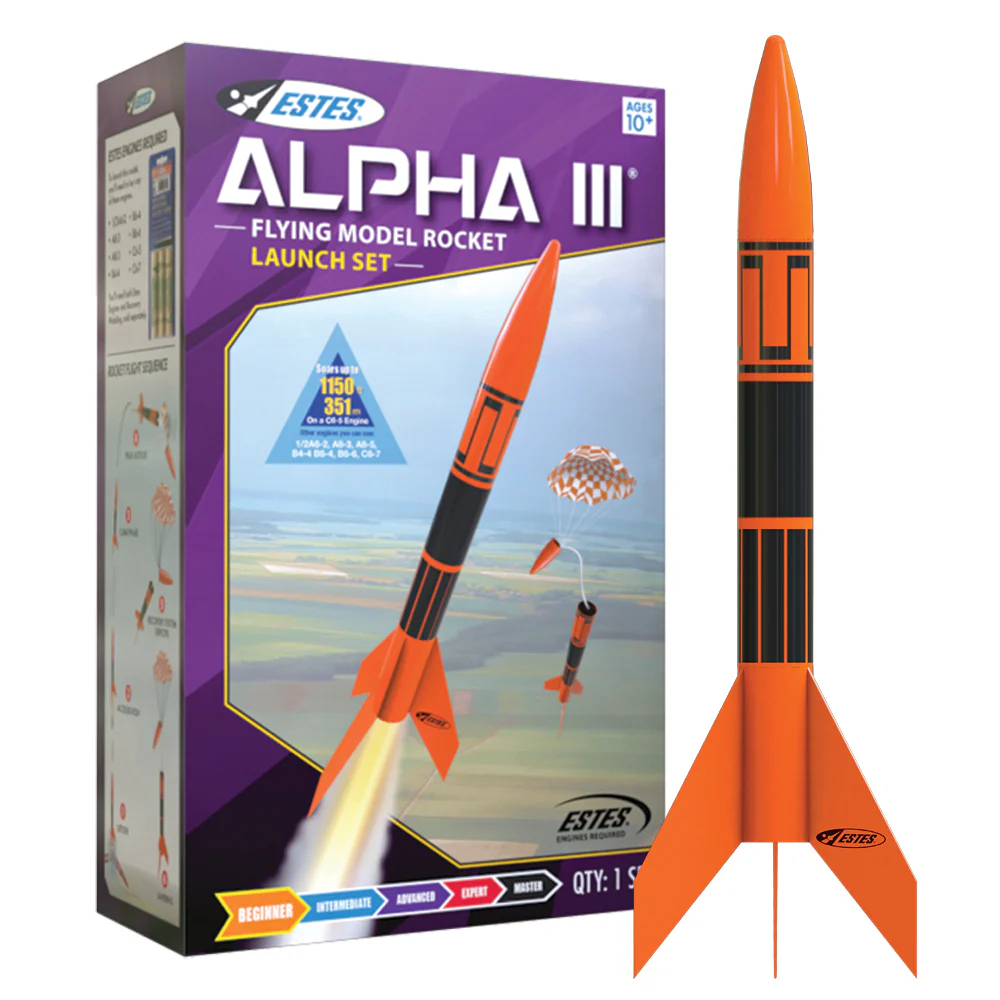 Best beginner model rocket
Best beginner model rocket
Estes Alpha III Launch Set
This classic launch set from Estes contains almost everything you need to launch your first rocket, including the launch pad, rocket engines, starters and batteries. You just need some basic hobby supplies for assembly and you’re good to go.
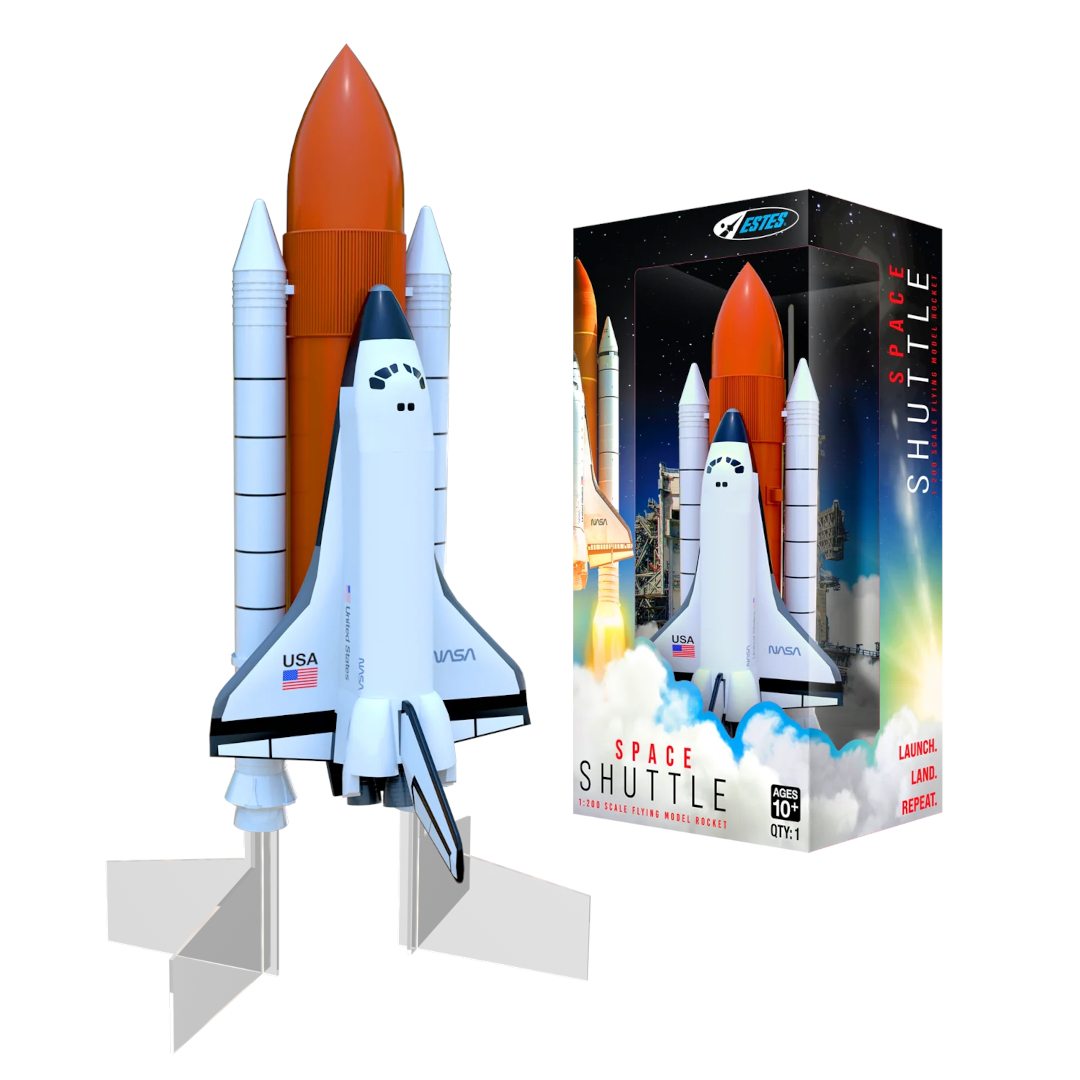 Best space shuttle model rocket
Best space shuttle model rocket
Relive the Space Shuttle's glory days with this ready-to-fly kit from Estes. The iconic shuttle is recreated beautifully, and the rocket booster section even detaches during the flight, letting the lander glide back to Earth.
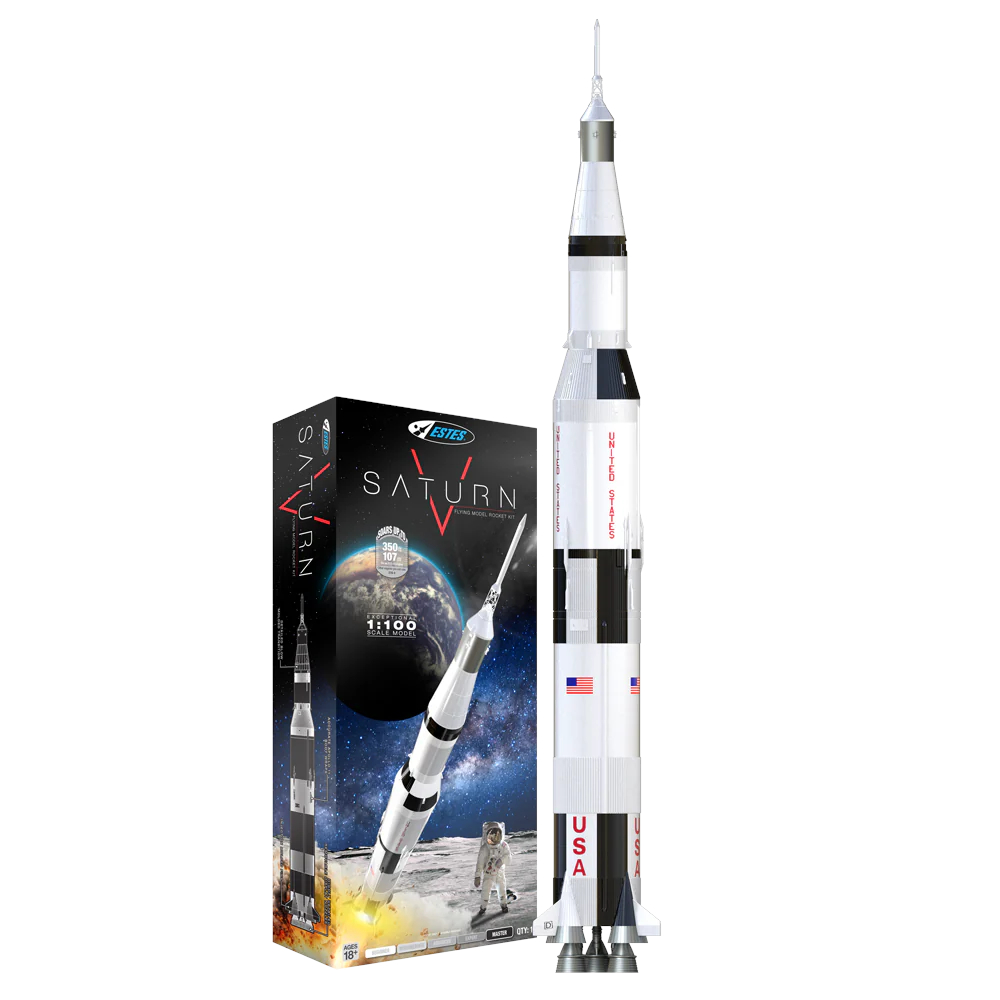 Best Saturn V model rocket
Best Saturn V model rocket
Expert rocketeers, behold — the Saturn V Master series set. This mammoth rocket is a real project for you to build and paint, standing over a meter tall when it's finished. It's not cheap, but it's worth every penny.
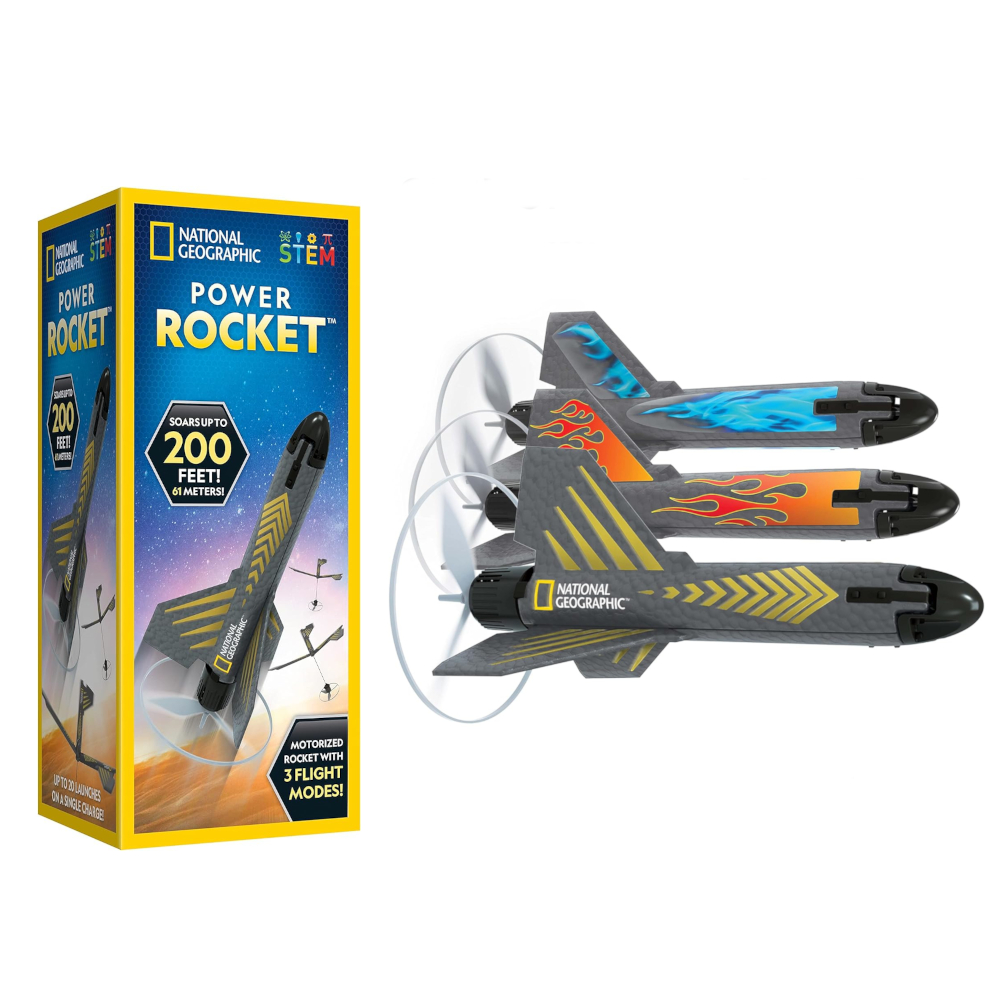 Best model rocket for kids
Best model rocket for kids
National Geographic Power Rocket
If your youngsters are a little too young to be messing with literal rocket engines, this propeller-powered alternative National Geographic is an ideal alternative. You get everything you need for flight included in the box, and it even has multiple flight settings.
Load the next 2 products ↴
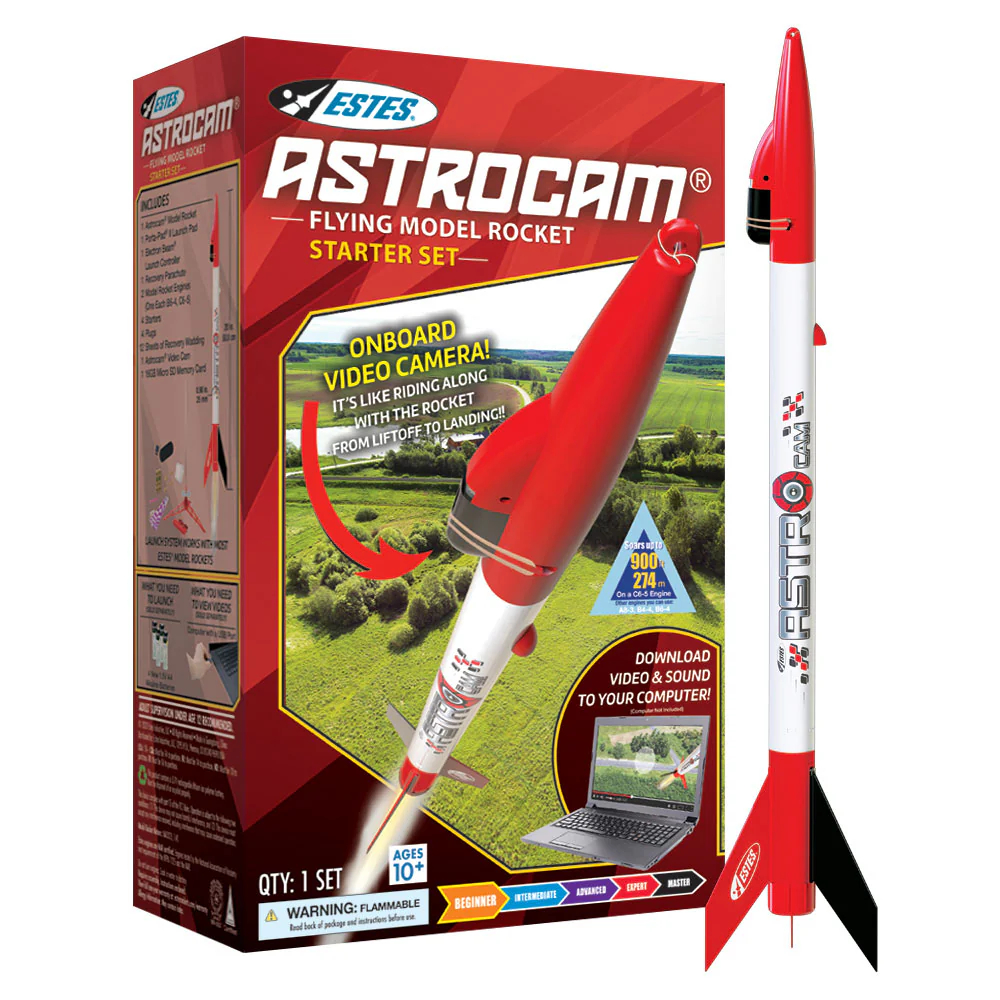 Best model rocket with a camera
Best model rocket with a camera
Estes AstroCam Starter Set
See your rocket launch from a new angle with the Estes AstroCam Starter Set, which includes a HD camera aiming downwards to capture your rocket's graceful ascent towards the stars. This set reaches an impressive 900 ft and comes with everything you need for blast off in the box.
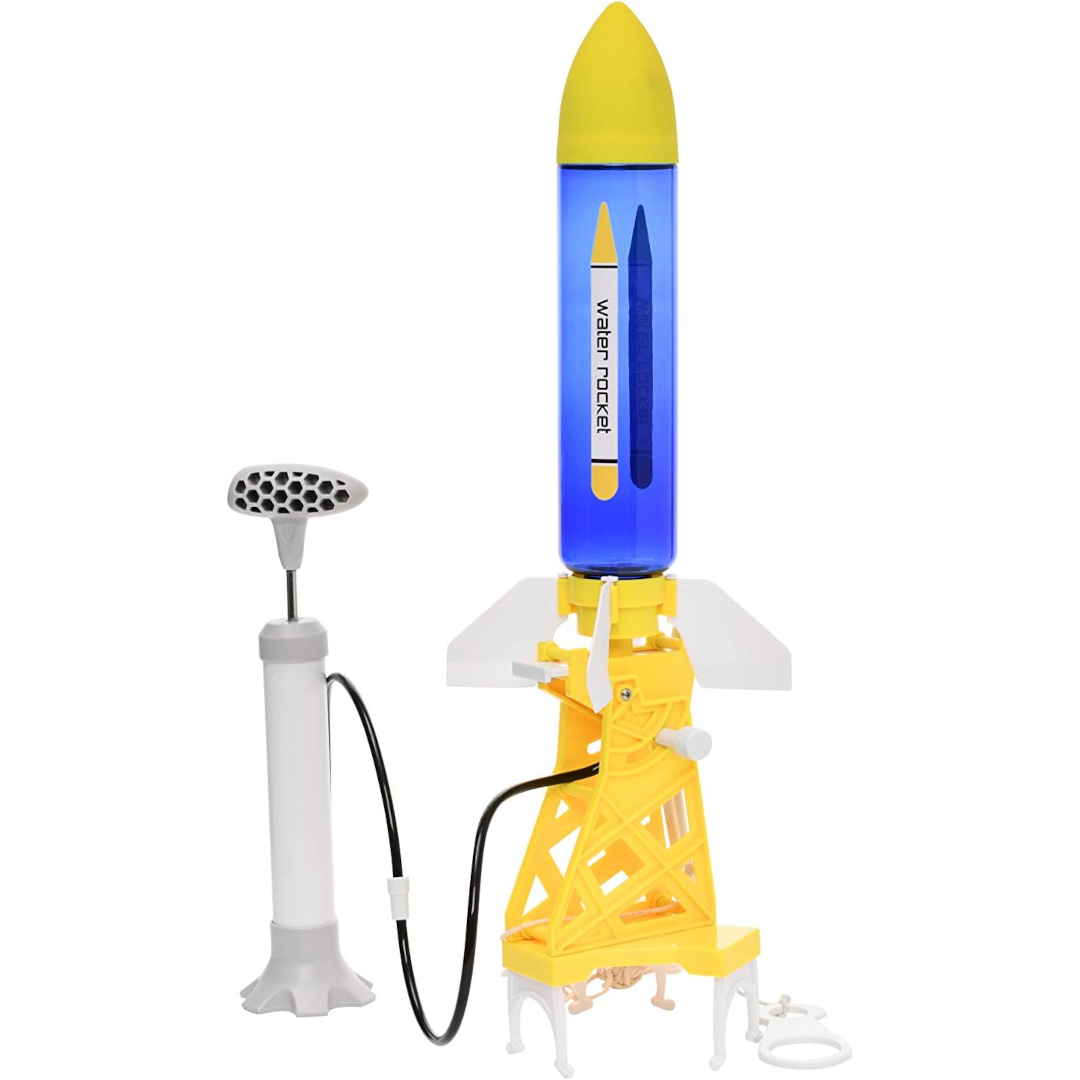 Best water-powered model rocket
Best water-powered model rocket
PLAYSTEM Water Powered Rocket Science Kit
Blast off like Blastoise with this hydro-pump-powered rocket set from PLAYSTEM. It comes with easy-to-follow instructions that explain the mechanics of what's happening inside the rocket, as you pump up the air pressure and send it off into the sky.
Best model rocket overall
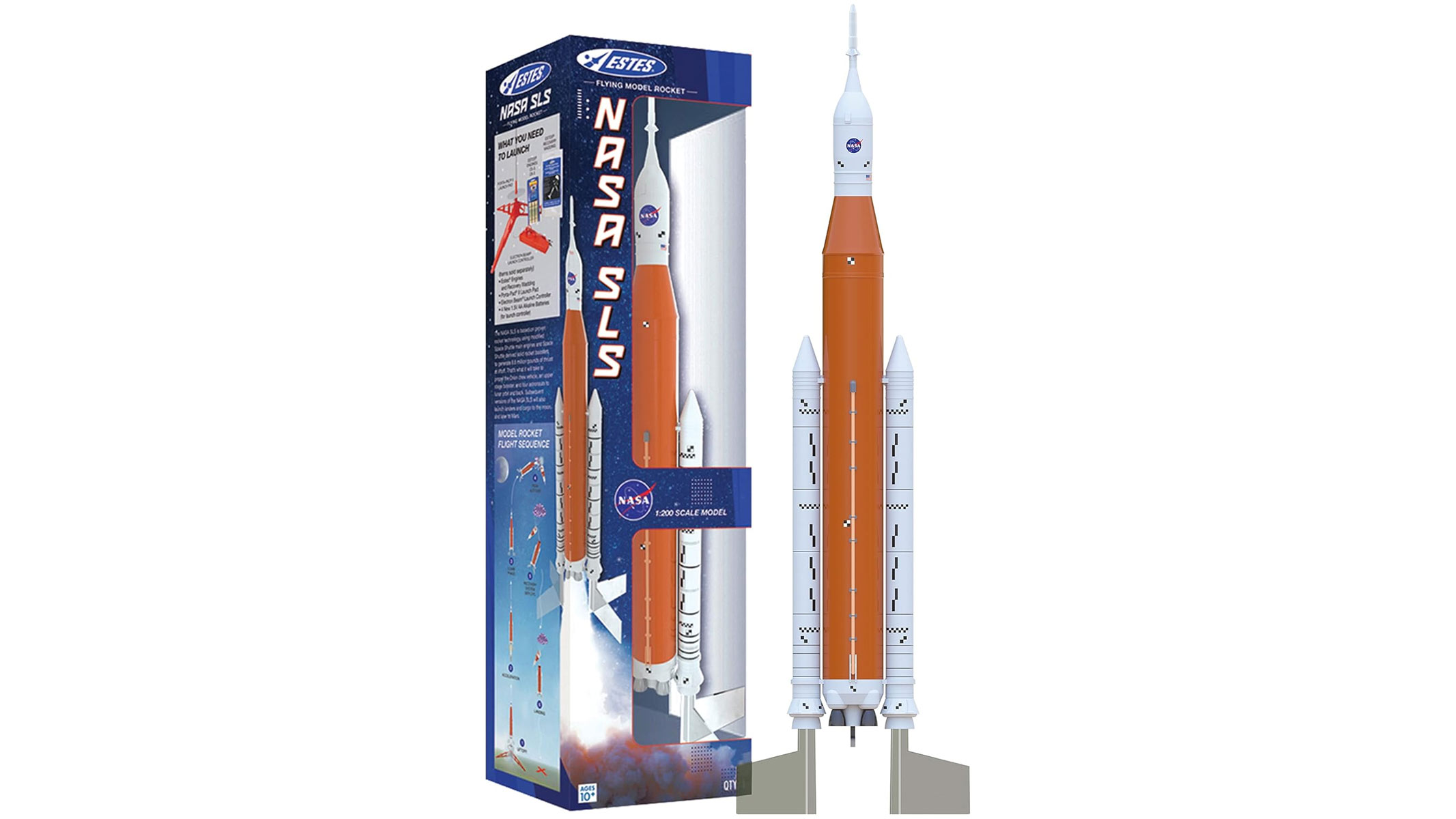
Estes NASA Space Launch System
The best model rocket overall, it's a lightweight yet plenty powerful replica of the iconic orange rocket.
Specifications
Length: 19.4 (49.3 cm)
Diameter: 1.64 inches (0.42 cm)
Weight: 4.2 oz. (119.1g)
Recommended engines: C5-3, C6-3
Launch system: Porta-Pad II
Projected maximum altitude: 350 ft. (107m)
Recovery System: 15 in. (38.1 cm) Parachute
Age: 10+
Reasons to buy
+ Ready to fly out of the box Cool design Affordable Great for beginners
Reasons to avoid
- Experienced model rockets might find it a bit basic.
Buy it if
You want something affordable and cool: This is an affordable entry point into model rockets and it's an awesome-looking design.
Don't buy it if
You're a veteran flyer: This is a great model for beginners, if you have plenty of experience already, you could fly this, or you could opt for something more sophisticated.
The bottom line
An iconic look and cheaper than other models: This set comes pre-finished, so you don't need previous experience to get going, it's more affordable than other models and it looks awesome, what's not to like?
Estes makes a load of different rockets based on real-world NASA craft, but our favorite has to be their replica of NASA's latest effort — the Space Launch System that will take Project Artemis back to the moon (and beyond).
This 1:200 scale replica stands 19.4 inches tall, 1.64 inches in diameter and weighs just 4.2 oz — quite a bit smaller than the real thing, which is taller than the Statue of Liberty and weighs 2750 tons! The upside is that the cost is a lot smaller too, with the set coming in at $76.99 on the Estes store. Add around another $50 for the launch pad and some engines, and you can replicate NASA's space program for under $130.
Unlike some of the more complicated Estes kits, the NASA SLS comes pre-finished and ready to launch. Simply attach the fins, load the rocket engine, place it on the launch pad and you're ready for lift-off.
We love the attention to detail on the rocket model. All the markings and insignia are where they should be, and there are even sculpted details like the fuel piping on the main booster tank. Customer reviews on the Estes site are very positive, noting that it flies well and it's a great kit for beginners.
Best Blue Origin model rocket
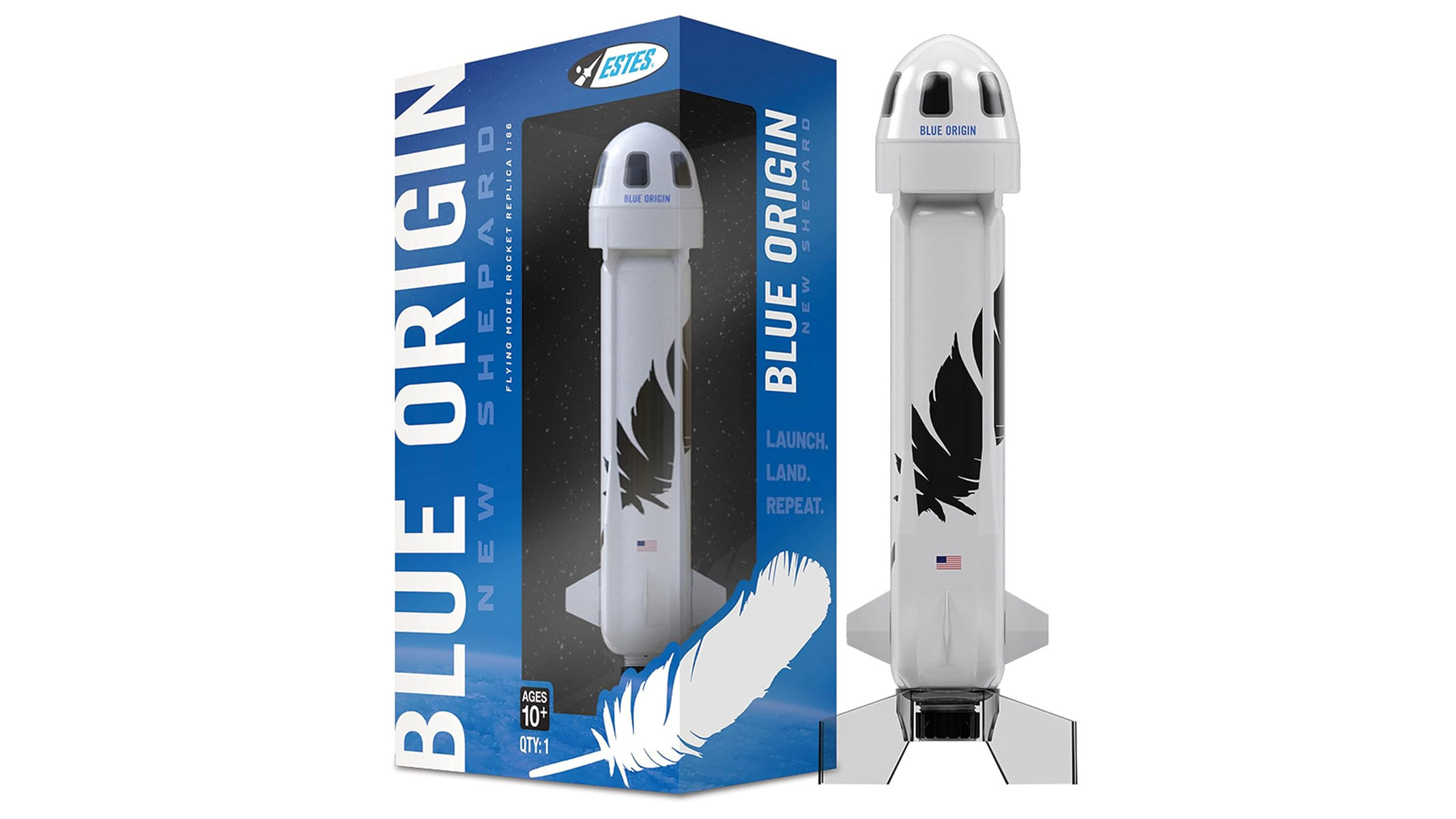
Estes Blue Origin New Shepard
Affordable, well made and instantly recognizable, this is the best Blue Origin model rocket on the market.
Specifications
Length: 10.34 in. (26.3 cm)
Diameter: 1.78 in. (45.2 mm)
Weight: 4 oz. (113.4 g)
Recommended engines: C5-3, C6-3
Launch system: Porta-Pad II
Projected maximum altitude: 400 ft. (122 m)
Recovery System: 15 in. (38.1 cm) Parachute
Age: 10+
Reasons to buy
+ Great replica Easy to operate Affordable
Reasons to avoid
- Rocket design won't be to everyone's taste
Buy it if
You want a great-looking replica: Simply put, this is instantly recognizable and looks like the real thing.
Don't buy it if
Blue Origin isn't for you: There are other great replica rockets out there, and affordable ones too, so you don't need to get a Blue Origin model if it isn't for you.
The bottom line
An affordable replica: This model is a great replica and instantly recognizable, it's affordable and easy to operate too, making it an attractive option for beginners and fans of replicas.
NASA isn't the only game in town anymore when it comes to American spaceflight, and that's reflected in the Estes range with this beautiful Estes Blue Origin New Shepard model rocket.
It's a ready-to-fly, 1/66th scale model of the Blue Origin New Shepard launch vehicle that recently took Billionaire founder Jeff Bezos to the edge of space. The New Shepard is named after Alan Shepard, the first American in space, to honor his pioneering legacy and now you can do the same (albeit on a smaller scale).
The Estes Blue Origin New Shepard measures 10.34 in. in length and uses either Estes C5-3 or C6-3 engines to reach a height of up to 400 ft. You'll need to buy the launch pad and rocket engines separately, but otherwise, this rocket is ready to fly out of the box making it ideal for beginners. There is also an intermediate builder's kit of the New Shepard available which is slightly bigger and flies much higher — up to 700 ft.
The model kit replicates the Blue Origin rocket wonderfully, with the iconic bulbous shape of the crew cabin and striking design down the rocket's length. Customers on Amazon have given it an average review score of 4.7 out of five (from 92 ratings) praising the rocket's design and performance.
Best model rocket for beginners

Estes Alpha III Launch Set
Compact and lightweight, the Alpha III comes with a launch system making it ideal for beginners.
Specifications
Length: 12.1 in. (30.7 cm)
Diameter: 0.98 in. (25 mm)
Weight: 1.2 oz. (34 g)
Recommended engines: 1/2A6-2, A8-3, A8-5, B4-4, B6-4, B6-6, C6-5, C6-7
Launch system: Porta-Pad II (included)
Projected maximum altitude: 1150 ft. (351 m)
Recovery System: 12 in. (30.5cm) Parachute
Age: 10+
Reasons to buy
+ Easy to build Launch system included Great launch height
Reasons to avoid
- Maybe too basic for experienced rocketeers
Buy it if
You're a beginner: This is an excellent beginner model, it comes with a launch system and it's easy to build.
Don't buy it if
You're experienced with rockets: This is a beginner set, if you're a veteran then you might want something that will test your skills a bit more.
The bottom line
The best beginner option: This is the best beginner option out there, so if you're looking to get into model rockets, this is a good place to start.
The Alpha III was the first beginner-level rocket that Estes ever produced, and it's been responsible for getting generations of space enthusiasts into the model rocket hobby.
Unlike most of the rockets on this list, the Alpha III includes the Porta-Pad II Launch Pad and Electron Beam Launch Controller, which is astonishing value given that the standalone launch pad costs more than this entire rocket set. You will still need to grab some engines and a few other accessories, and there is a standalone version if you already have the launch pad, but for beginners, this set is the way to go.
It's not a pre-built rocket, so you will have to assemble it, but that's half the fun and thanks to the easy-to-assemble parts, you'll be able to get the whole thing built and ready to fly in under an hour.
This is one of Estes best selling rockets and it's easy to see why thanks to the easy build and excellent value for money. The Alpha III has nothing but five-star reviews on the Estes site, with people praising the easy build, great launch height, and value for money.
Best space shuttle model rocket
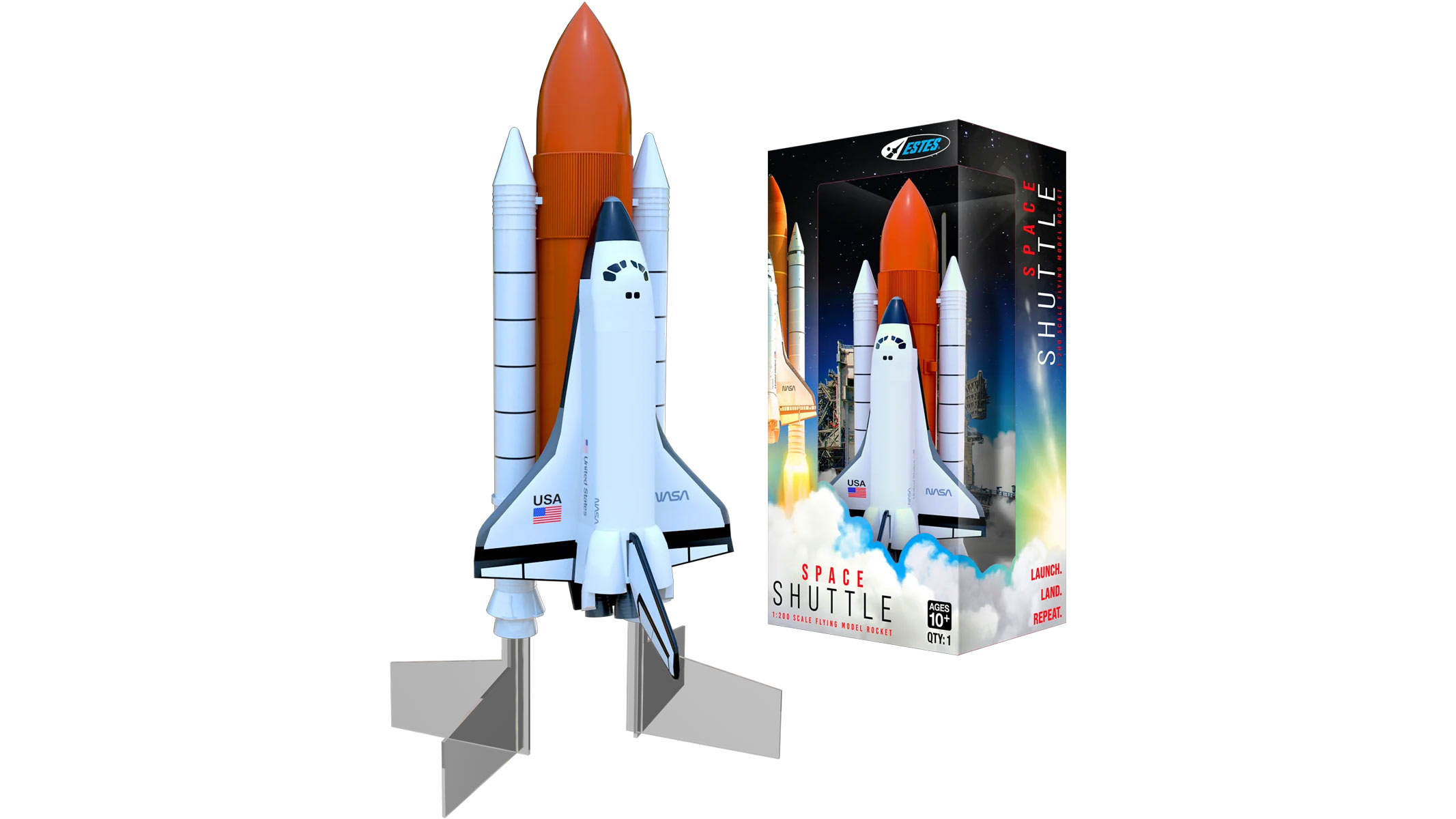
The best space shuttle model rocket on the market, there's no mistaking what it is and it can soar to heights of 600 ft.
Specifications
Length: 10.9" (277mm)
Diameter: 1.64" (41.5mm)
Weight: 3.7 ounces (105 grams)
Recommended engines: C5-3, C6-3
Launch system: Porta-Pad II
Projected maximum altitude: 600 ft (122 m)
Recovery System: 15 in. (38.1 cm) Parachute
Age: 10+
Reasons to buy
+ Ready to fly Looks awesome Display stand included
Reasons to avoid
- 1:1200 scale is quite small Expensive for a ready to fly kit
Buy it if
You want something ready to fly: This set is ready to fly and boasts the iconic look of a space shuttle.
Don't buy it if
You're on a budget: There are cheaper sets available and for a kit that comes ready to fly, this is quite expensive.
The bottom line
Good but expensive for what it is: This kit is ready to fly and looks really cool as a space shuttle, but there are cheaper kits available.
The Space Shuttle is arguably the most iconic spacecraft in human history, making it the perfect choice for a model rocketeer. The Estes Space Shuttle is a 1:200 scale model of the legendary craft, complete with booster rockets and a fuel tank. This set is ready to fly with no assembly required making it a great choice for beginners.
The orbiter detaches from the booster rocket section, just like the real thing, gliding down to Earth while the parachutes keep the booster section safe on its descent. Reviewers have noted how smoothly the shuttle descends, gliding down on a circular trajectory and gently touching down.
You also get a display stand included, so you can show it off when it's not in flight. The Space Shuttle is one of the more expensive ready-to-fly kits in the Estes range, so if you're looking for pure value, you'll do better elsewhere, but in terms of sheer spectacle, the Space Shuttle is tough to beat.
Best Saturn V model rocket
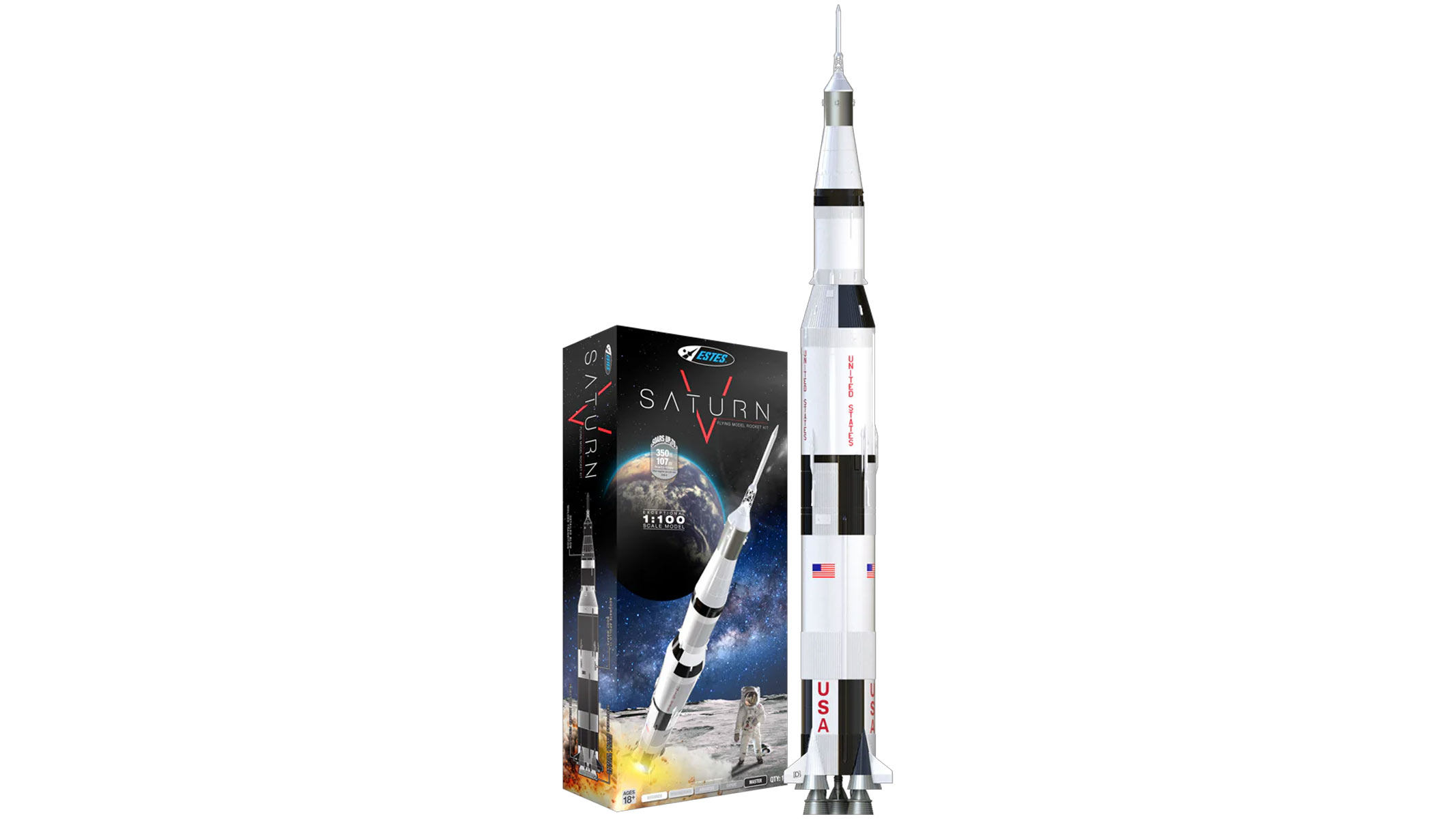
A bit of a monster when ready to fly, the best Saturn V model rocket will look awesome flying through the air.
Specifications
Length: 43.25 in (109.86 cm)
Diameter: 3.94 in (100.08 mm)
Weight: 15.3 oz (28.35 g)
Recommended engines: E16-4, F15-4
Launch system: Porta-Pad E
Projected maximum altitude: 350 ft. (106.7 m)
Recovery System: 24 in. (60.96 cm) Parachute
Age: 10+
Reasons to buy
+ Enormous Detailed build Looks great in flight
Reasons to avoid
- Not suitable for beginners Expensive
Buy it if
You want a big rocket: This is a sizable set measuring over 40 in. in length, so it will look awesome flying through the air.
Don't buy it if
You're a beginner: This set isn't really for those trying their hand at rocketeering. It's expensive and a detailed build, which might put some beginners off.
The bottom line
A big rocket with a detailed build: It's an expensive set but you get bang for your buck with an impressive figure flying through the air that requires effort to build.
Move over tiny rockets, the enormous Estes Saturn V is here. Coming in at just over a meter tall, this one dwarfs most of the other sets on our list. It also represents a serious step up in difficulty as it's part of Estes' Master level range. Estes has been producing Saturn V kits since the 70s, but they refreshed and updated this kit a few years ago to bring it to a modern-day standard.
You'll need to assemble the rocket yourself, and it's quite an involved process. Fortunately, Estes has a handy list of all the extra tools you'll need to get this thing ready for launch. You'll also need to buy the usual accouterments alongside the rocket — Porta-Pad E launch pad, rocket engines, parachute, and batteries.
Once it's done though, it's a thing of beauty. Packed with details including all the insignia, flags and writing you'd find on the real thing, it looks fabulous sitting on the launch pad and even better soaring through the sky.
It has an average customer review score of 4.83 out of five on the Estes website with a total of 18 reviews. Positive reviews praise the high build quality and stunning design, with the only complaint coming from shipping issues.
Best model rocket for kids
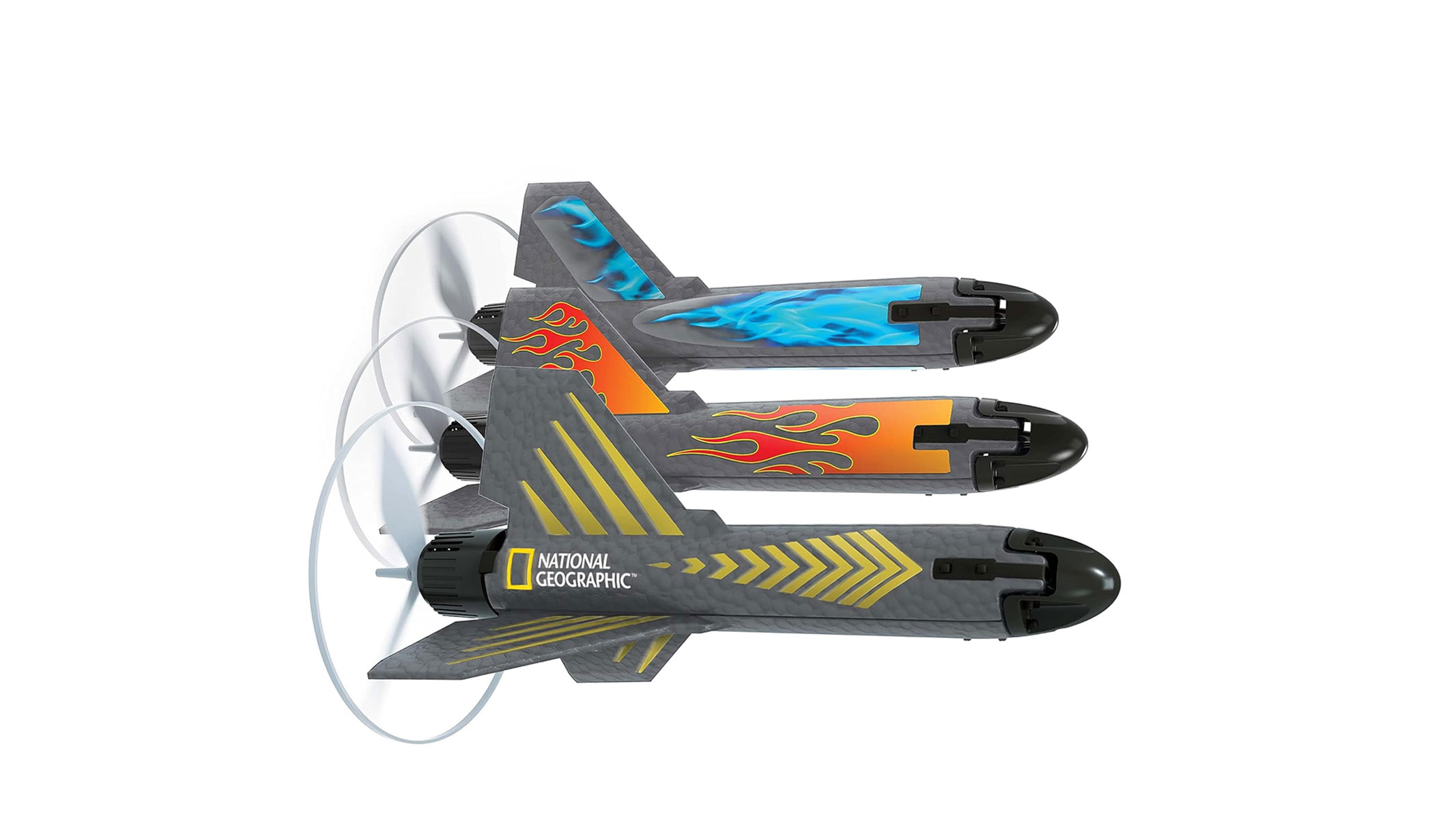
National Geographic Power Rocket
This compact and propeller-powered rocket uses safer materials, making it the best model rocket for kids.
Specifications
Length: 12 inches (30.5 cm)
Diameter: 5.2 inches (13.2 cm)
Weight: 13.4394 oz. (381 g)
Recommended engines: Battery-powered motorized propeller (included)
Launch system: N/A
Projected maximum altitude: Up to 200 ft
Recovery System: Propeller landing system
Age: 8+
Reasons to buy
+ Kid-friendly (no flammable materials, safe landing) Multiple flight settings Contains everything you need, no extras required
Reasons to avoid
- Not a conventional model rocket Lower maximum height than actual model rockets
Buy it if
You're buying for kids: This is a great kid-friendly option and it comes with everything you need to fly it.
Don't buy it if
You want a traditional model rocket: This set doesn't use conventional engines but propellors, if you want the engine experience, this isn't for you.
The bottom line
A great option for budding rocketeers: With safe landing and materials used and a lower maximum height than other rockets, this is a great entry option for young enthusiasts.
We're leaving the world of Estes behind for this model rocket, and looking at an unconventional, but awesome alternative from National Geographic. While most model rockets use, well… actual miniature rocket engines, the National Geographic Power Rocket uses a motorized rotary propellor to recreate the effect of a rocket launch, without the need for the explosives.
It has adjustable settings for three different heights, with a maximum altitude of around 200 ft on the highest setting. The whole thing is powered by a rechargeable battery and it can handle up to 20 flights on a single charge.
It's not going to be to everyone's tastes, but this emphasis on safety makes this a perfect introductory set for young kids. They get to experience the wonder of a rocket launch with their own eyes, and if they get hooked you can introduce them to "proper" model rockets down the line.
There are some other big advantages to the National Geographic Power Rocket too. It doesn't need a separate launch pad, and it has a secondary rotor that extends out to slow the rocket's descent, meaning you don't need to buy perishable parachutes.
Best model rocket with a camera
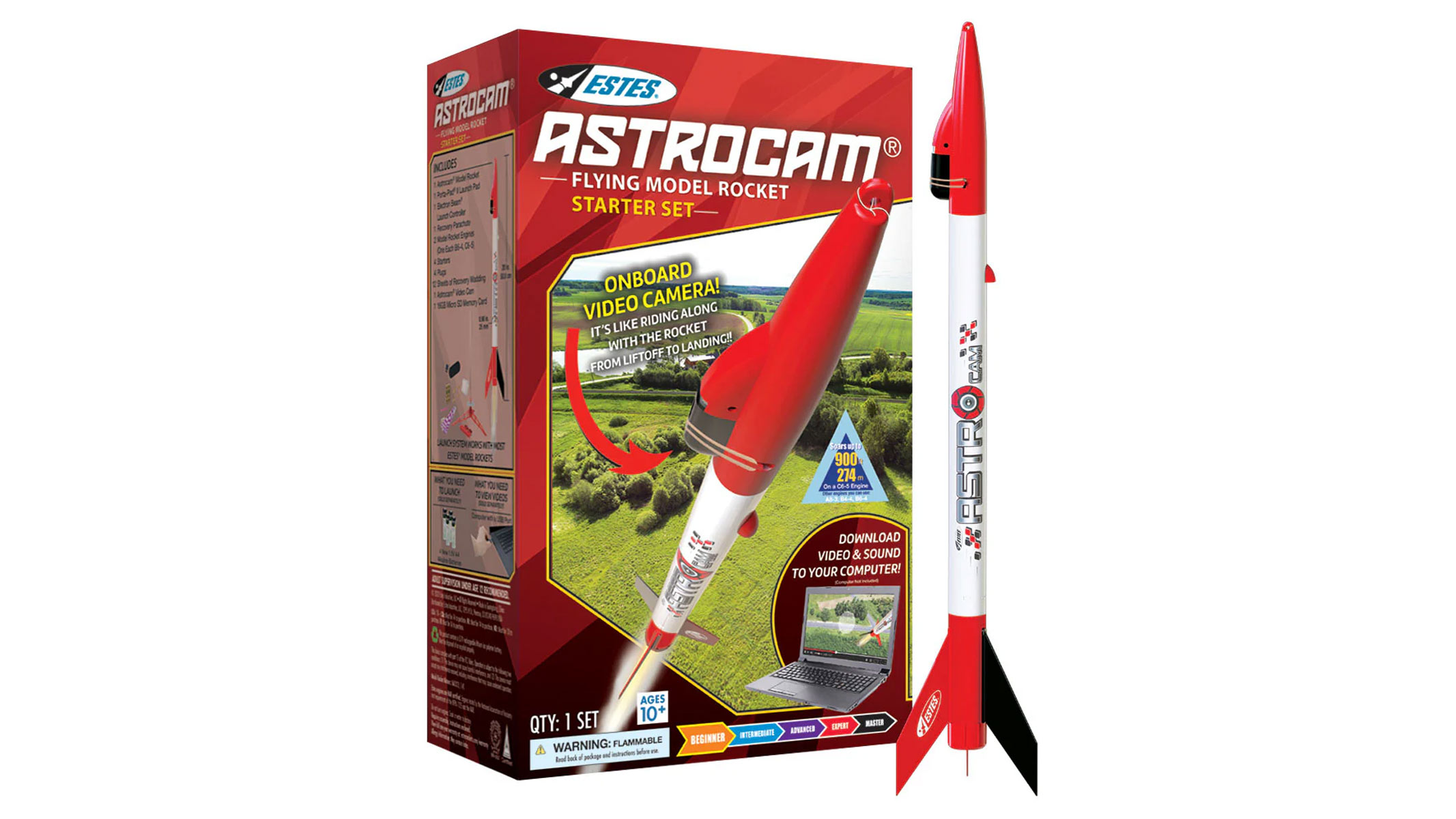
Estes AstroCam Starter Set
If you're looking for FPV footage on your rocket, you want the Estes AstroCam as it comes with a camera attached.
Specifications
Length: 20 in. (50.8 cm)
Diameter: 0.98 in. (25 mm)
Weight: 1.5 oz. (42.6 g)
Recommended engines: A8-3, B4-4, B6-4, C6-5
Launch system: Porta-Pad II
Projected maximum altitude: 900 ft. (274 m)
Recovery System: 15 in. (38.1 cm) Parachute
Age: 10+
Reasons to buy
+ Included camera for epic launch videos Comes with launch pad and engines High maximum altitude
Reasons to avoid
- A-series engines underperform
Buy it if
You want a camera on your rocket: With a camera included on this rocket, you can capture awesome launch videos, without working out how to do it with your own camera.
Don't buy it if
You want top-of-the-line engines: The engines on this set are a little underwhelming, it doesn't ruin the kit but it's worth noting.
The bottom line
A camera and high altitude: This rocket is able to achieve a 900ft max altitude with a camera attached for launch videos and it comes with a launch pad for take-off.
Launching model rockets into the skies is one thing, but being able to record point-of-view videos takes it to a whole new level, and that's exactly what the Estes AstroCam offers. It has a HD camera built into the nose of the rocket, pointing downwards to record your craft's glorious ascent onto the included 16GB Micro SD card.
In addition to the nifty camera, the AstroCam Starter Set also comes with almost everything you need to perform your first rocket launch, including the launch pad, two rocket engines, plugs, starters, and a parachute.
It has an impressive maximum altitude of 900 ft (274m), making it one of the highest climbing rockets on our list — perfect for shooting epic launch videos. Reviews on the Estes website are super positive with an average rating of 4.38 out of five. People love the included camera and value for money, though one reviewer did recommend sticking with B-series engines for the AstroCam, as they felt the A-series didn't provide enough lift.
Best water-powered model rocket
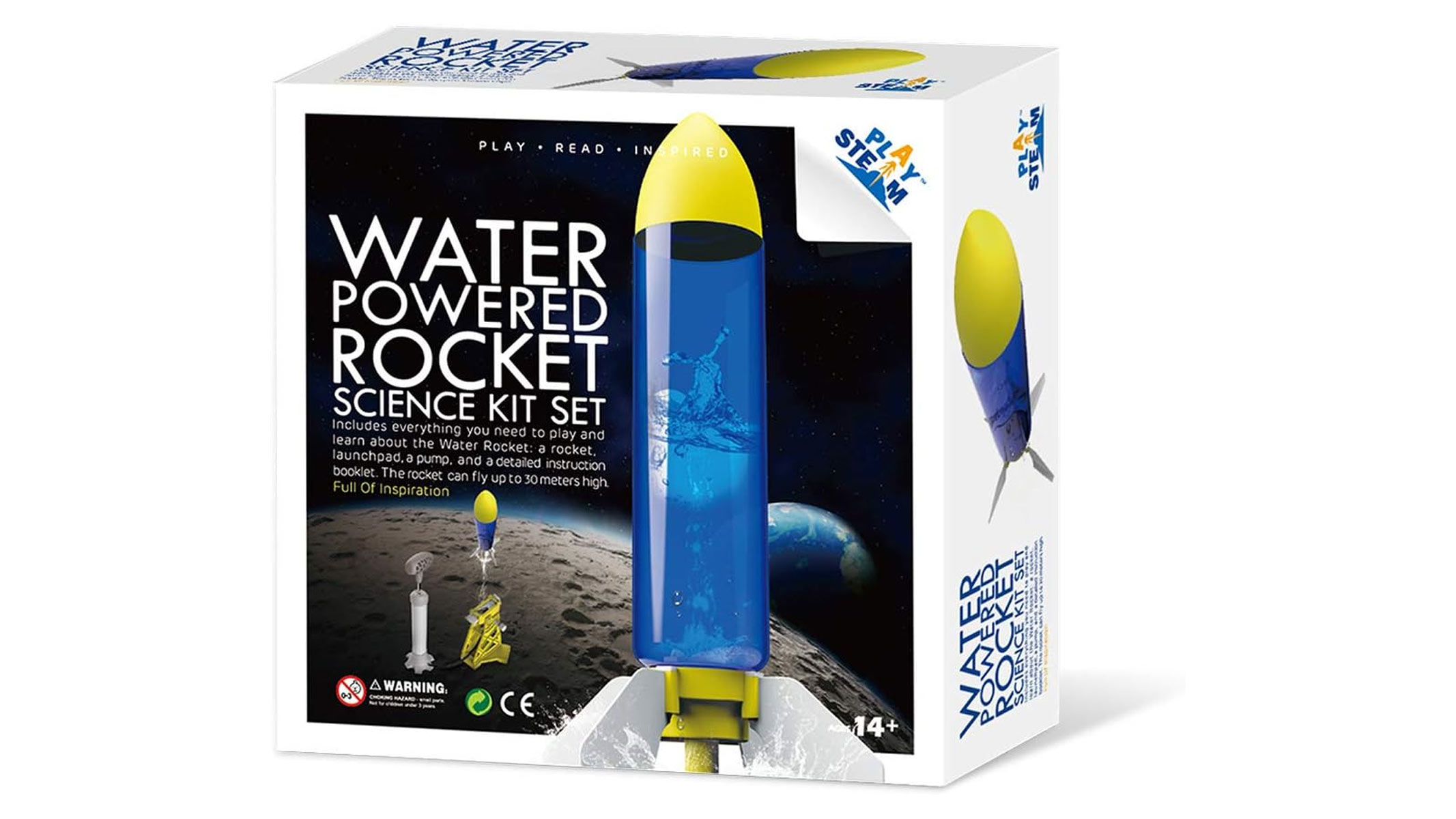
PLAYSTEM Water Powered Rocket Science Kit
Another great option for kids, this water-powered STEM set is totally safe and a ton of fun, we think it's the best water-powered model rocket out there.
Specifications
Length: 9 in. (22.9 cm)
Diameter: 2.75 in (7 cm)
Weight: 14.1 oz. (399.7 g)
Recommended engines: Water pump (included)
Launch system: Launch pad (included)
Projected maximum altitude: 100 ft
Recovery System: N/A
Age: 8+
Reasons to buy
+ Kid-friendly (no flammable materials, safe landing) Affordable Science and learning booklet
Reasons to avoid
- Not a conventional model rocket Doesn't go as high as others
Buy it if
You're buying for a kid: This rocket isn't very big, is affordable and uses water along with child-friendly materials.
Don't buy it if
You want a conventional rocket: Conventional materials and systems aren't used here, as it's aimed at younger users, and other rockets will achieve higher altitudes.
The bottom line
Water propelled rocket for kids: This rocket is a water-powered and affordable option suitable for kids and younger users looking to get into model rockets.
Another unconventional choice to round out this list. We've had combustion power, we've had propeller power, and now we've got hydro-power with the PLAYSTEM Water Powered Rocket Science Kit.
Operation is simple. The rocket is half filled with water, and you then use a pump to build up the air pressure inside. Once you've reached sufficient pressure, pull the release valve and the rocket blasts off, expelling a trail of water behind it as it goes. The instruction booklet is thorough, and filled with lots of neat science titbits and facts too.
Again, this isn't a conventional model rocket so experienced rocketeers might scoff at it. It won't go nearly as high as some of the proper rockets on this list, but 100 ft is still mighty impressive and at the end of the day it's a cheap, fun and safe way for your young kids to experience the joy of a rocket launch.
How we test
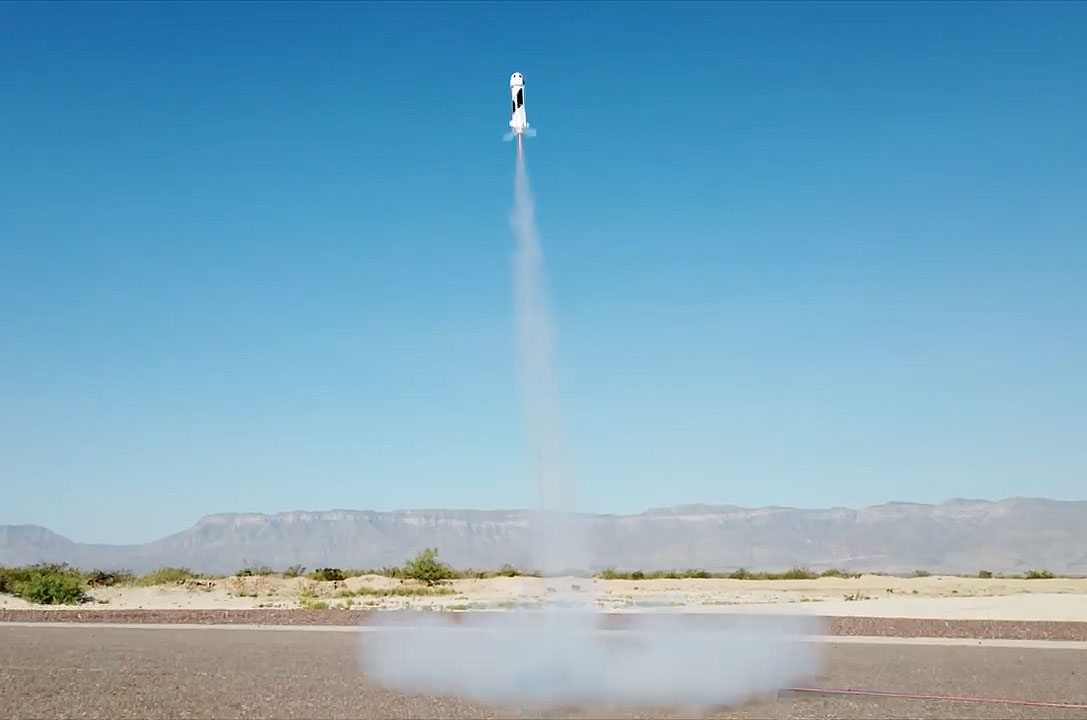
To guarantee you're getting honest, up-to-date recommendations on the best model rockets to buy here at Space.com, we've put in some serious research time. Some of our senior staff are model rocket enthusiasts and we've picked their brains, as well as considering specs and design, to come up with our list.
Above, you'll find the specs, in-depth, as well as pros and cons to each model rocket that we believe is worthy of its place among the best model rockets on the market. Some of our staff, including Editor-In-Chief, Tariq Malik, have been obsessed with model rockets for years and own sets themselves, which has helped with our process of selecting the top models available.
Our long-term goal is to write full reviews of the rockets in this guide in the future. We'll be getting to work filling out our model rocket review line-up soon, starting with the rockets currently on this list, before moving on to new releases.
With complete editorial independence, Space.com is here to ensure you get the best buying advice on model rockets to help you choose which (if any) model you should purchase. Our aim is to make our buying guides and reviews reliable and transparent.
FAQs
Are model rockets safe?
In short, yes. Of course, it's vital that you know what you're doing, follow instructions and launch when you have clear weather and an open space so that you take every precaution to avoid any incident, as some materials used can be flammable. But, model rockets have been launched as a hobby for decades and this wouldn't be possible if they weren't safe.
If you're introducing younger kids to the hobby, you can use rockets that have propellers or are water-powered and don't use flammable materials for an extra safety measure.
What do I need to launch a model rocket?
Unfortunately, you can't just buy a rocket and expect it to fly, you'll need a kit to launch it. This should include: an engine, to provide the thrust; a stable launch pad, so the rocket has a stable base to launch from and won't be thrown of course from the start; recovery wadding, so the parachute and other recovery systems are protected on the ascent (the rocket can't just be launched and free-fall from the sky); a controller and/or igniters, so that the engine can ignite and launch can begin; suitable space and weather, depending on the power of your engine and a maximum altitude of the rocket, you'll need a lot of open space, so a back yard might not be enough. It's also important you avoid launching in windy or stormy conditions to minimize the risk of losing control.
Who are the best manufacturer of model rockets?
Here at space.com, we reckon Estes is the best model rocket manufacturer on the market. They have been making model rockets since the late 1950s and have a range of models suitable for different experience levels and replica models of famous spacecraft. Of course, there are other reliable alternatives out there, including Revell, Airfix, National Geographic, and others.
How high can a model rocket fly?
That depends on the rocket you're using. Some well-designed model rockets, with powerful engines, can fly thousands of feet in the air. But not all are like that. Many suitable for beginners and intermediates will reach altitudes of between a few hundred feet and a thousand feet. Model rockets aimed at kids, not using traditional engines will reach lower maximum altitudes, which is ideal as they will still fly high enough to capture the imagination, but there's less risk of losing control.
What weather conditions do I need to launch a model rocket?
Clear skies and no wind are the safest conditions for flying model rockets. You don't want to launch a rocket into clouds as you may lose sight of it and you don't know if anything else is in the clouds. You also don't want wind as it can knock a rocket off course and it can become harder to control. Of course, you also want clear, open space to avoid collisions and buildings in both ascent and descent.
May 15: We've changed the format of this guide to include a quick list, more specific information and categories for each model rocket. We've also added an FAQ section and a "How we test" section so you have as much information as possible.
.png)
 German (DE)
German (DE)  English (US)
English (US)  Spanish (ES)
Spanish (ES)  French (FR)
French (FR)  Hindi (IN)
Hindi (IN)  Italian (IT)
Italian (IT)  Russian (RU)
Russian (RU) 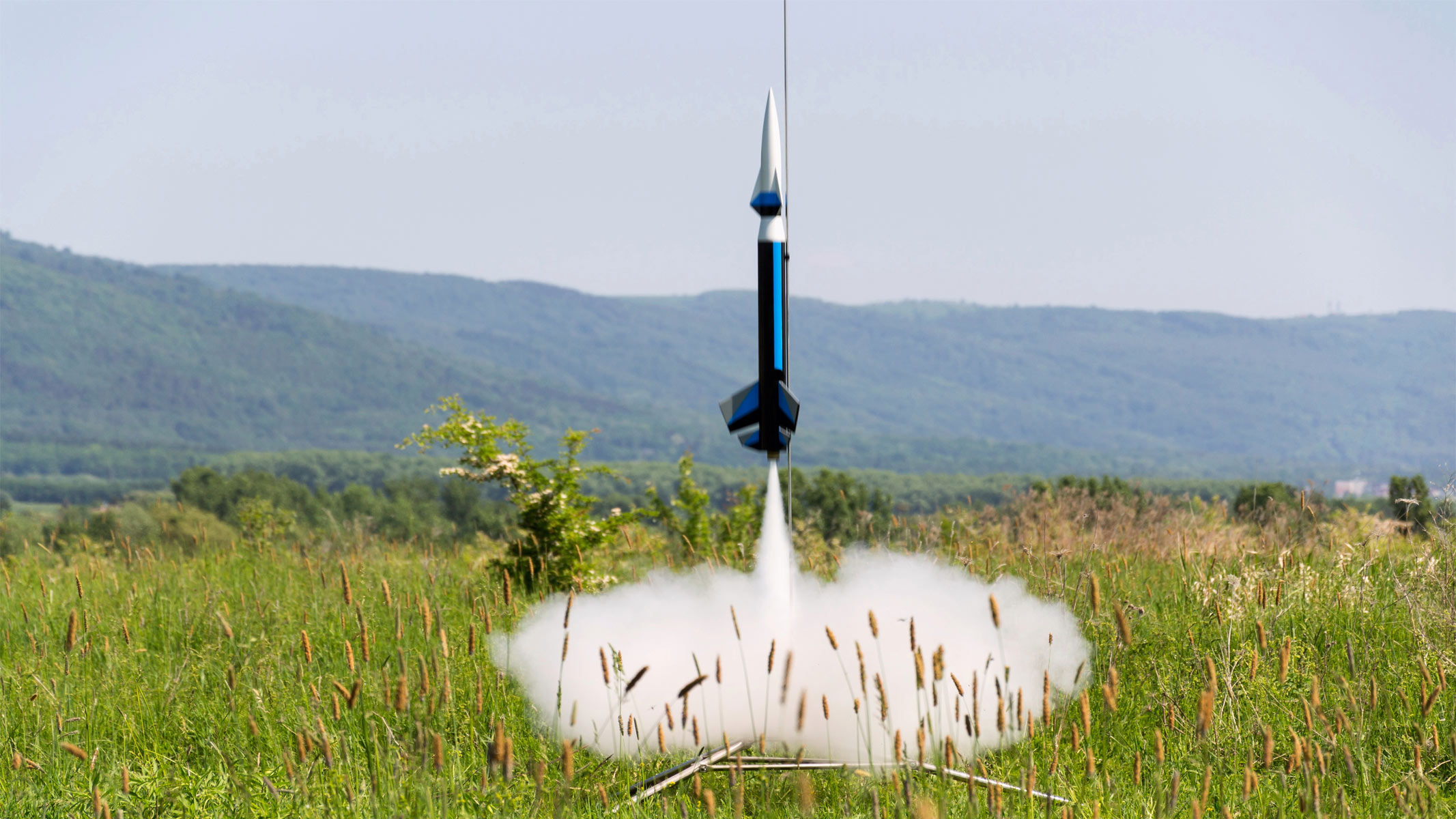
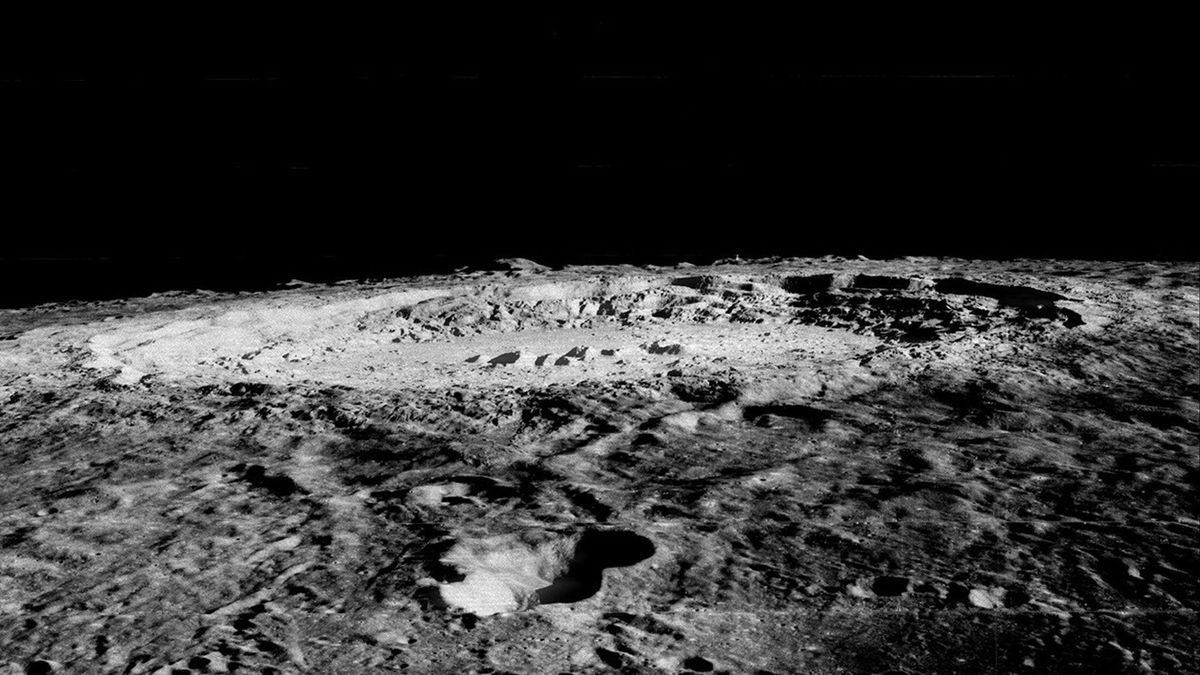
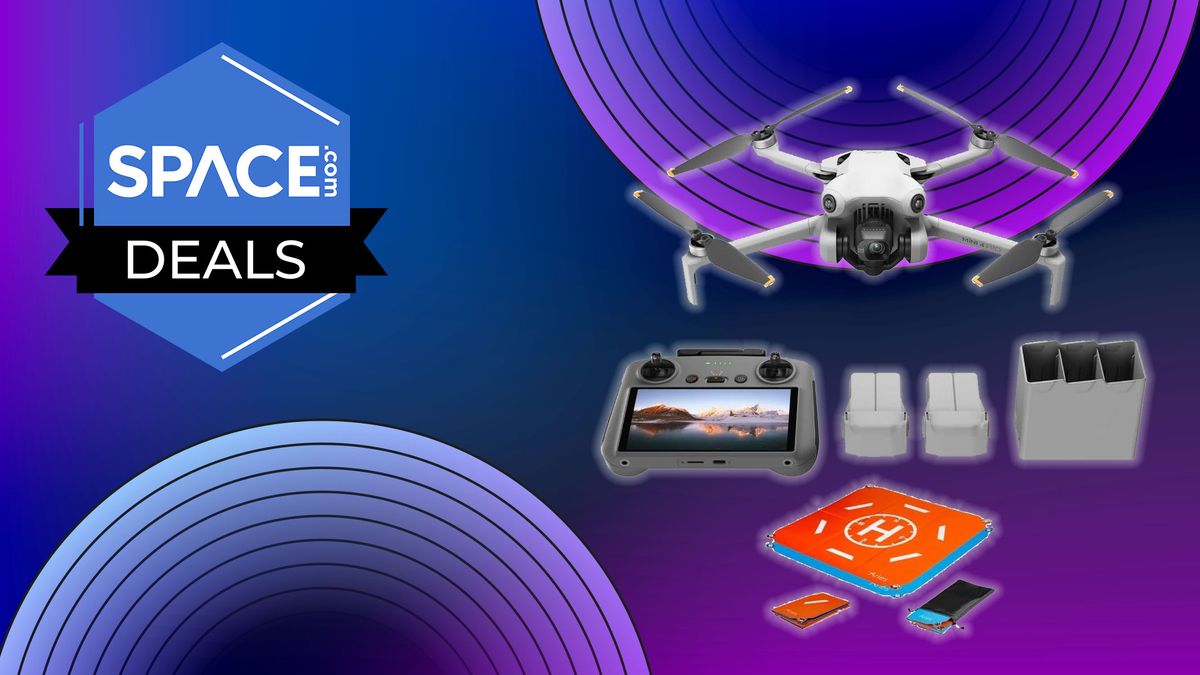







Comments